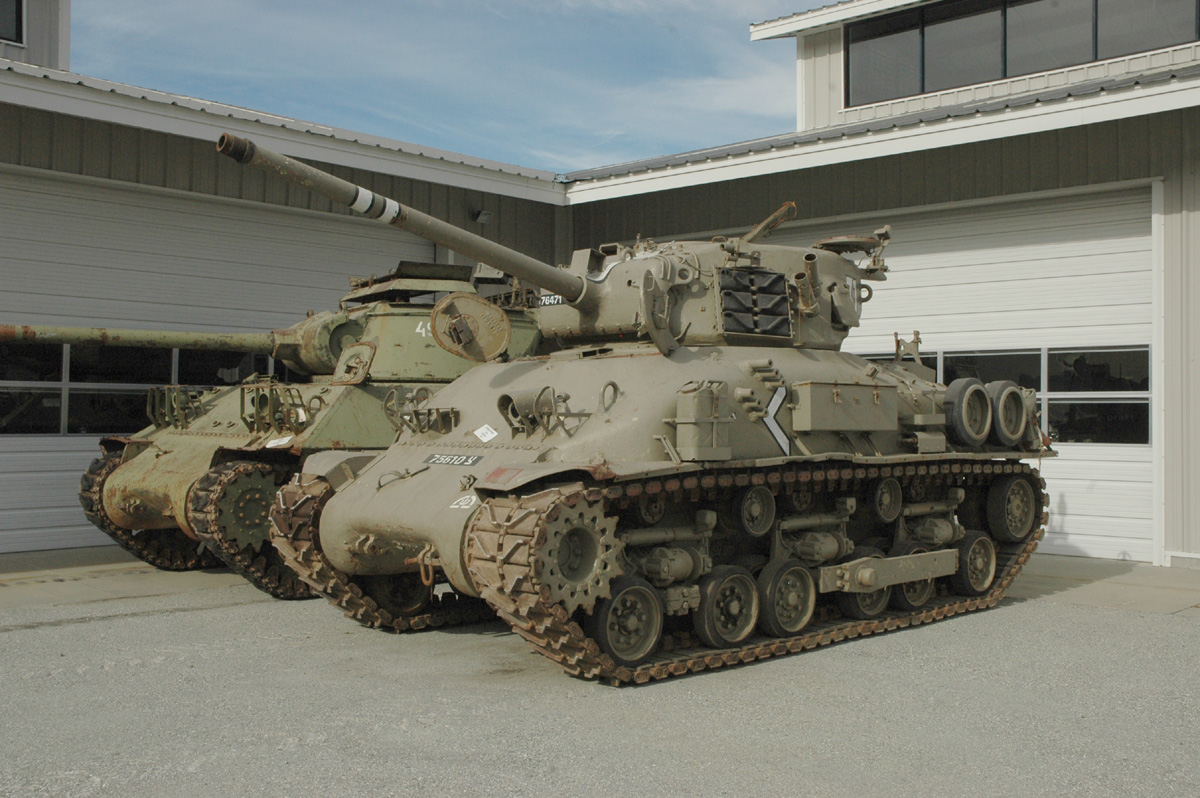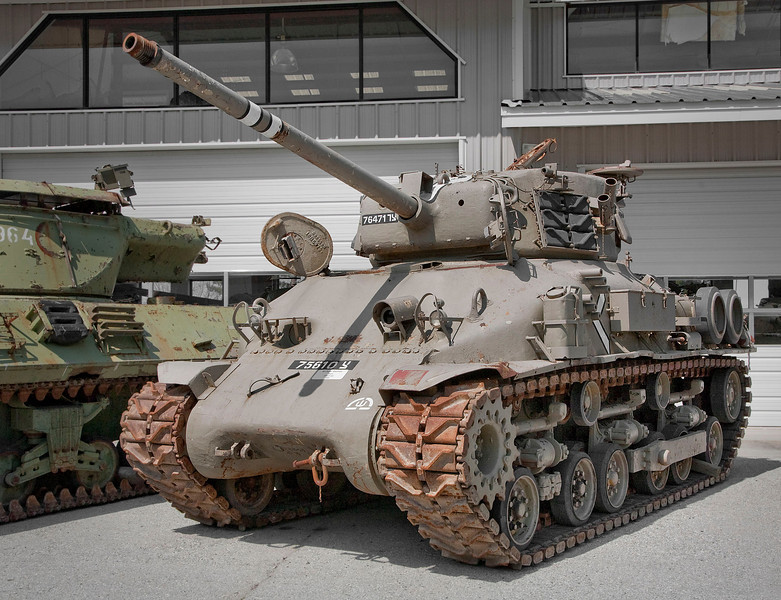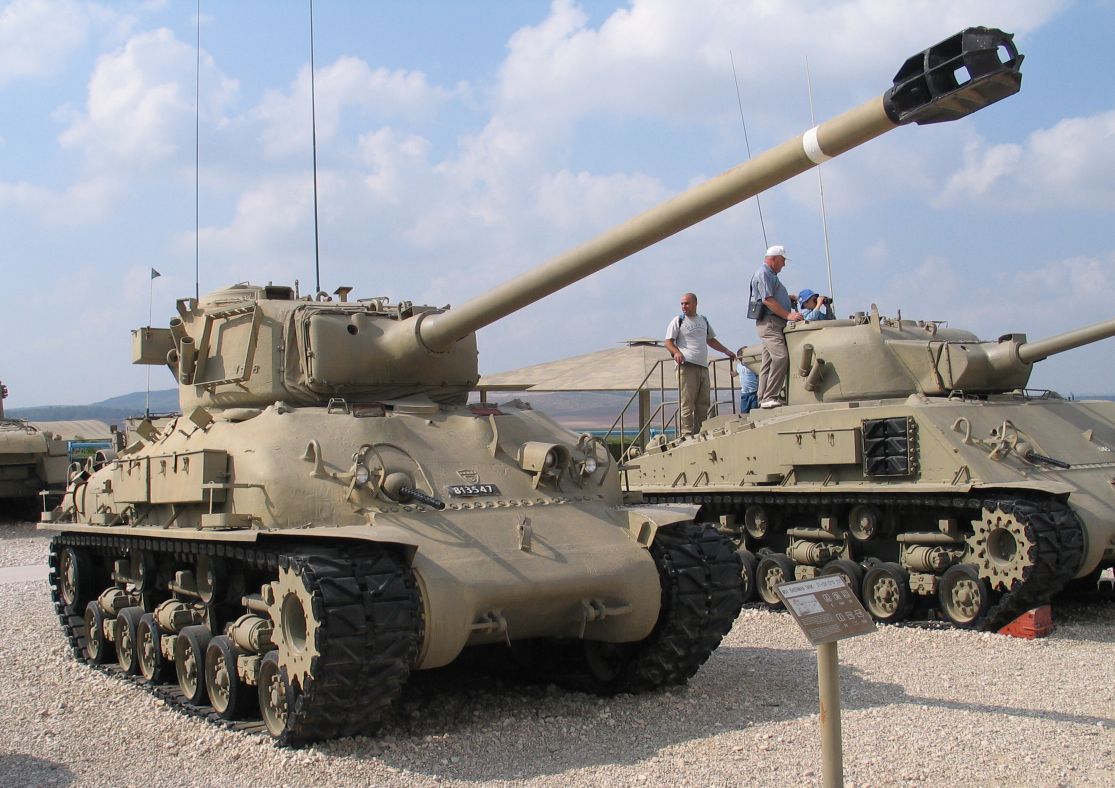The Sherman M-50 and the Sherman M-51, both known abroad as the Super Sherman, were modified versions of the American M4 Shermantank that served with the Israel Defense Forces from the mid-1950s to early 1980s. The M-51 was also referred to as the Isherman (i.e. Israeli Sherman). However, the designations "Super Sherman" and "Isherman" were never used by the Israeli Defense Forces.
History
In 1953, an Israeli delegation visited France to examine the new AMX 13 light tank. The tank was armed with the high-velocity 75 mm gun CN 75-50. While the gun was satisfactory, the armor of the French tank was considered too light. Eventually, Israel did purchase the AMX 13, however in a parallel development it was decided to graft the powerful French gun onto the available, familiar and better-armored hull of the American M4 Sherman, the standard tank of the IDF armored units in the early 1950s.
The project started in 1954, and in 1955 a prototype turret was sent from France to Israel.In March 1956 Israeli Ordnance Corps facilities started to convert tanks, using guns received from France. The gun was known in Israel as the M-50 and as a result the upgunned Sherman was designated Sherman M-50. The M-50 was similar to the Sherman Firefly in that it had the original turret of the smaller type (as used by the 75 mm gun M3 armed Shermans), which was fitted with a large counterweight at the rear en
The first 50 units were based on M4A4 hulls, had a Continental R-975 gasoline engine and VVSS suspension. However, the increased weight of the vehicle combined with narrow tracks led to poor off-road mobility. It was also putting too much strain on the engine, resulting in frequent mechanical failures. Consequently, for the rest of the conversions, hulls fitted with HVSS suspension and Cummins V-8 460 horsepower (340 kW) diesel engine were adopted.These subvariants were sometimes referred to as the M-50 Continental and M-50 Cummins. Diesel engines were also preferred since diesel fuel is less flammable than gasoline, which factors into battlefield survivability. In total, about 300 M-50s were built by 1964 (though it's possible that this number includes 120 155 mm self-propelled guns on Sherman chassis, also designated M-50).
The same gun was also fitted to a number of M10 tank destroyers
In the 1960s, 180 Sherman tanks received the even more powerful French 105 mm Modèle F1 gun. The barrel length of the gun was reduced from 56 caliber to 44 and equipped with a muzzle brake; ammunition was altered to use a smaller cartridge. In Israel the gun was designated M-51 and the tank the Sherman M-51. M4A1 hulls and the larger T23 turrets (from 76 mm armed Shermans) were used for the conversion. All tanks were fitted with Cummins diesel engines and HVSS suspension. The tank was displayed to the public for the first time during the Independence Day ceremony in 1965.
Abroad the M-50 was known as Super Sherman (the "Continental" variant as Mark I and the "Cummins" variant as Mark II) and the M-51 as either Super Sherman or Isherman (i.e. Israeli Sherman). These designations were never used in Israel. The only tank model designated Super Sherman by the IDF was M4A1 with 76 mm M1 gun and HVSS suspension, which was named Super Sherman M-1
Service history
The first 25 M-50s were finished just in time for Operation Kadesh - the Israeli 29 October 1956 invasion of the Sinai - against the Egyptian Army(which also employed its own up-gunned version of the M-4 Sherman, fitted with the French AMX-13 turret, making it equal to the M-50 in firepower).
In 1964, Israel started to divert water from the Sea of Galilee to the Negev Desert for agricultural purposes. The Arab nations were in uproar, and Syria began a project to divert water into Jordan (the Headwater Diversion Plan). Maj General Israel Tal had trained Israeli tank gunners to shoot beyond 1,500 metres (1,600 yd) and, on March 6, 1965, an M-50, commanded by Tal, engaged a Syrian recoilless rifle that had killed an Israeli tractor driver; Tal personally destroyed the recoilless rifle at long range. A few days later, General Tal, with an M-50 and a Centurion Mk III tank, was waiting for a chance to fire upon the Syrian water diverting project. When Syrian gunners fired on a border patrol, Tal's M-50 and the Centurion fired on eight tractors 2,000 metres (2,200 yd) away, and destroyed them all in two minutes with 10 shots - Tal destroyed 5 tractors with his M-50's 75 mm gun, and the Centurion destroyed the remainder
Both the M-50 and M-51 saw combat in the Six-Day War that left the Golan Heights, the West Bank, and the Sinai peninsula in Israeli hands, often fighting against Soviet World War II-era armor like the T-34-85 (for example at the Battle of Abu-Ageila). Both were also employed in the 1973 Yom Kippur War alongside and against much more modern tanks. The use of such seemingly obsolete tanks was necessary given the desperate nature of the fighting.
In combat against the Arab armies, the M-51 proved itself capable of fighting newer, heavier tanks like the Soviet-built T-54/55/T-62. The M-51's 105 mm gun could penetrate these adversaries using HEAT ammunition. The M-51 served well during its time, and is regarded as an excellent example of how an obsolete tank (the Sherman) can be upgraded beyond the limits of its original capabilities.
The M-50 Continentals were retired by 1972. The M-50 Cummins and M-51 were gradually phased out in late 1970s to early 1980s. During the Lebanese Civil War, some 75[clarification needed]M-50s were given as aid to the Israeli-supported Lebanese Christian militias – Kataeb Regulatory Forces (19), Tigers Militia (20), Guardians of the Cedars (1), the Lebanese Forces (40), and the South Lebanon Army (35) – in 1976; two tanks were later captured by the Palestine Liberation Organization (PLO), which employed them in the defense of West Beirut during the June 1982 Israeli invasion of Lebanon
Israeli Shermans: These Modifications Kept The Sherman Relevant Into The 70s!
Israeli use of the Sherman tank would be long and glorious, with updated models using extremely upgraded guns, seeing action for decades after WWII. They would use the chassis for more things than the US Army did. They also went with their own strange naming system, making trying to figure out the Israeli Shermans even harder. There is also not a lot of good books in English on the subject, and Hunnicutt only has a little info on them and I think it’s a tad out of date. This section will be updated as I find out more info on the subject and or correct what is here, based on newer better info.
In the dark early days when Israel was struggling to become a nation, they managed to get ahold of a few Shermans. Three or so were acquired from the British, probably M4A4s. They also managed to get de-milled Shermans from Junk vendors in Europe. They had to re arm some with an old German 75mm field gun, they were called Sherman (Krupp). When they managed to get ahold of a Sherman armed with a M3 75mm gun the tank was called a Sherman M-3, when it had a 105mm gun, it was a Sherman M-4. As you can see already, naming convention confusion has commenced



In the later fifties Israel was able to get more up to date Shermans. The tanks were M4A1 and M4A3 models with the 76mm M1A1/A2 gun, probably from France. These Shermans were called Sherman M1s, regardless of what motor or hull they had. If they had HVSS suspension, they were called Super Sherman M1. Some of these tanks had an upgraded engines, probably late in their careers, and with Cummings diesels.
The Story gets more interesting, and slightly less confusing in the naming area, when they started to rearm the tanks.

The M-51: In the early 60s the Israelis went to the French for help shoehorning an even bigger gun into the Sherman. They took a shortened version of the 105mm Model F1 gun; this was a modification of the gun used in the AMX-30. The gun retained a stabilizer, I’m not sure if it was the original Sherman one or a more advanced design. This gun could fling an AP round at 2969 feet a second and had a HEAT round that could penetrate 14 inches of steel. They chose to use M4A1 76 W tanks exclusively. These tanks had the larger T23 turret and they was helpful in getting the guns to fit. The French prototype retained its VVSS, and R975, but the Israeli production modifications had HVSS and the Cummings diesel fitted to the M-50 models. This was a 950 cubic inch diesel that put out 460 horsepower. This was enough horsepower along with the HVSS, to keep the tanks reasonably mobile, but they were no hotrods.
Both these tanks saw extensive combat use with Israel all the way into the 70s, and then a lot of them were sold off to collectors and museums or used as range targets.

 Six-Day War and Yom Kippur War
Six-Day War and Yom Kippur War
The first M51 was delivered in July 1962 and 180 had been modified by the mid-1960s. By this time the IDF possessed Centurions and M48 Pattons, but the M51s served alongside these newer tanks during the Six-Day War in June 1967 and were deployed mainly with the Aviram, Zippori, and 10th Armored Brigades. In particular, the 14th (Zippori) Brigade, which was part of General Ariel Sharon's armored division, saw extensive action in the Sinai Peninsula. When hostilities began on June 5th, the unit crushed the Egyptian 2nd Infantry Division's defenses and advanced 120km southwest to reach Nakhl after intense battles from Um-Katef to Abu-Ageila. M51s were present at the Golan Heights as well and were deployed in the northern flank during the offensive toward Quneitra. They also played an important role in the fierce fighting in the West Bank's Dothan Valley. M51s were again called into action during the 1973 Yom Kippur War. For example, the 9th Brigade's 595th Tank Battalion rushed to the Golan Heights immediately when the war began and pushed back Syrian armored units. In another noteworthy battle during the advance toward Damascus, General Dan Laner arrayed his four armored brigades, one of which included M51s, in a horseshoe formation and decimated an Iraqi Army armored force.
Despite having served with great distinction in these conflicts, the Sherman's WWII design was showing its age and the IDF retired them in 1980, with most of them being sold to Chile. However, the experience gained from the developement of the M51 helped lead to later tank modification programs as well as the creation of the IDF's home-grown Merkava main battle tank













































 r
r




 kr
kr










































































































